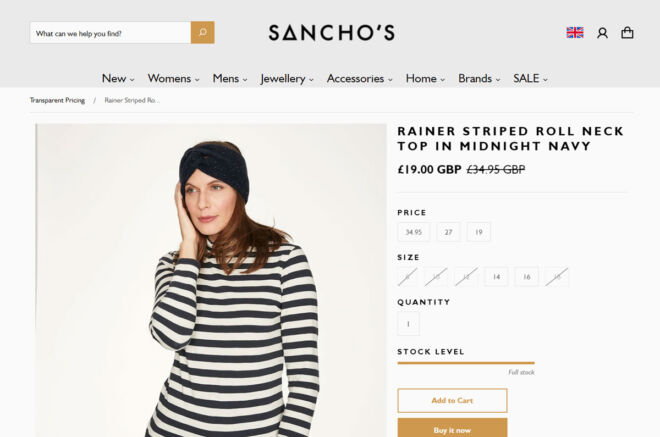The last year has seen many shops starting to offer online shopping as a standard option alongside their physical store.
For some this was their first foray in the world of ecommerce, while others have expanded and streamlined their offerings.
It’s clear that consumers have got used to the idea of being able to buy anything and everything online. I was really grateful that some of my favourite independent shops around Manchester have really stepped up their ecommerce game this past year.
I’ve bought all sorts online, from burger-making kits to Twin Peaks themed cocktails, and even a rose bush that came in a compostable envelope.
And this appetite for online shopping isn’t going anywhere, even after shops reopen this month.
Some retail experts even say a good ecommerce experience is crucial for shops to remain viable. David Jinks, head of consumer research at ParcelHero, told Internet Retailing: “Only retailers that embrace their website as their most important shop window and ensure their online service matches the standards of their in-store experience will survive.”
Let’s hope it’s not quite that dramatic, but the message is clear that shoppers want the convenience of getting what they need online. Here’s my thoughts on how businesses can provide a positive online shopping experience.
Click and collect is ace
With many people still a little – or a lot – worried about being indoors with others (anyone else flinch when they see crowds of people on TV or is that just me?), especially in small shops, it can be the perfect option to offer click and collect.
It’s also less hassle and cost for you, as you don’t have to package and post parcels, and there is still the human connection when people collect what they have bought (one of my lockdown ‘highlights’ was having a good old natter when picking up my orders from Rare Mags).
The same goes for local delivery. Often quicker than even the dreaded Amazon Prime, and almost certainly with less wasteful packaging.
Be sure to make these options prominent on your website and highlight how these benefit both the consumer and the planet.
Clearly explained size guides
When people can’t go into a shop to see items with their own eyes, touch them and try them on, your website needs to do the work.

In addition to great descriptions and photos, be sure to include dimensions of items, or in the case of clothing, provide size guides.
It’s also really important to offer reassurance to buyers that it will be simple to return items.
Product descriptions with personality
Product descriptions should be clear and convey all the most important details of a product, but that doesn’t mean they should be boring.
Use these bits of text to stand out and convey a bit of your brand personality.
If your SEO game is on point, people will likely find your website because of what you sell, however I love when the shop owner also says why they stock a product. Stories such as these create a personal connection and elevates products to being something of meaning.
Personal touches
Not meeting your customers in person makes it more difficult to connect on a human and emotional level. This is a barrier, but not insurmountable!
You can still convey your brand values through your packaging, for example if sustainability is important to you, you can use plastic-free packaging, and if your brand is quite fun, you can have a cartoon or humorous saying on your packaging.
The nicest way to convey that personal touch though is with a handwritten note to accompany the purchase.
Multi-tiered pricing
One very interesting concept I’ve seen was from Devon-based clothing store Sancho’s, which has a “Transparent Pricing” collection.

Sancho’s offers a reduced rate for people who may be struggling to pay the full price, the standard price, and then an overpayment option (if you’re in a more fortunate position) which helps pay towards someone else’s purchase.
Other web shops, like The Norah Store have the ability to round up the price to add a tip to the seller or make a charity donation.
ecommerce fails
But of course on the other hand, I’ve also encountered some of the dark side of online shopping, ranging from mild annoyances to just plain creepy. Not including the obvious stuff being frustratingly slow to load or looking crap on phones, here are some instant ways to make me leave an online shop.
Don’t make me have to make an account
Having the option to create an account is great if I’m making regular purchases.
However, forcing me to create an account when I’m making just a one-off purchase, it’s simply annoying. I just wanna buy a yoga mat without having to share a bunch of extra personal information and come up with a password!
Don’t automatically add me to your mailing list when I make a purchase
Imagine buying something and then receiving three sales emails before your order has even arrived. Nope. Give people the option to receive your marketing emails (it’s the law anyway) and then consider whether they want or need to hear from you just after they handed over their money.
Don’t email me if I abandon my basket
It’s creepy! It’s like chasing someone down the road when they leave your shop without buying the thing they looked at on the shelves.
The future will be a mix of online and offline
Even following the triumphant return of brick-and-mortar stores, online shopping is going to continue growing, and upping your ecommerce offering should be a consideration for all businesses.
If you would like advice on how to improve your online shop, let’s chat through some ideas in a power hour! You can also read how I’ve helped others design successful ecommerce websites in my case studies.
